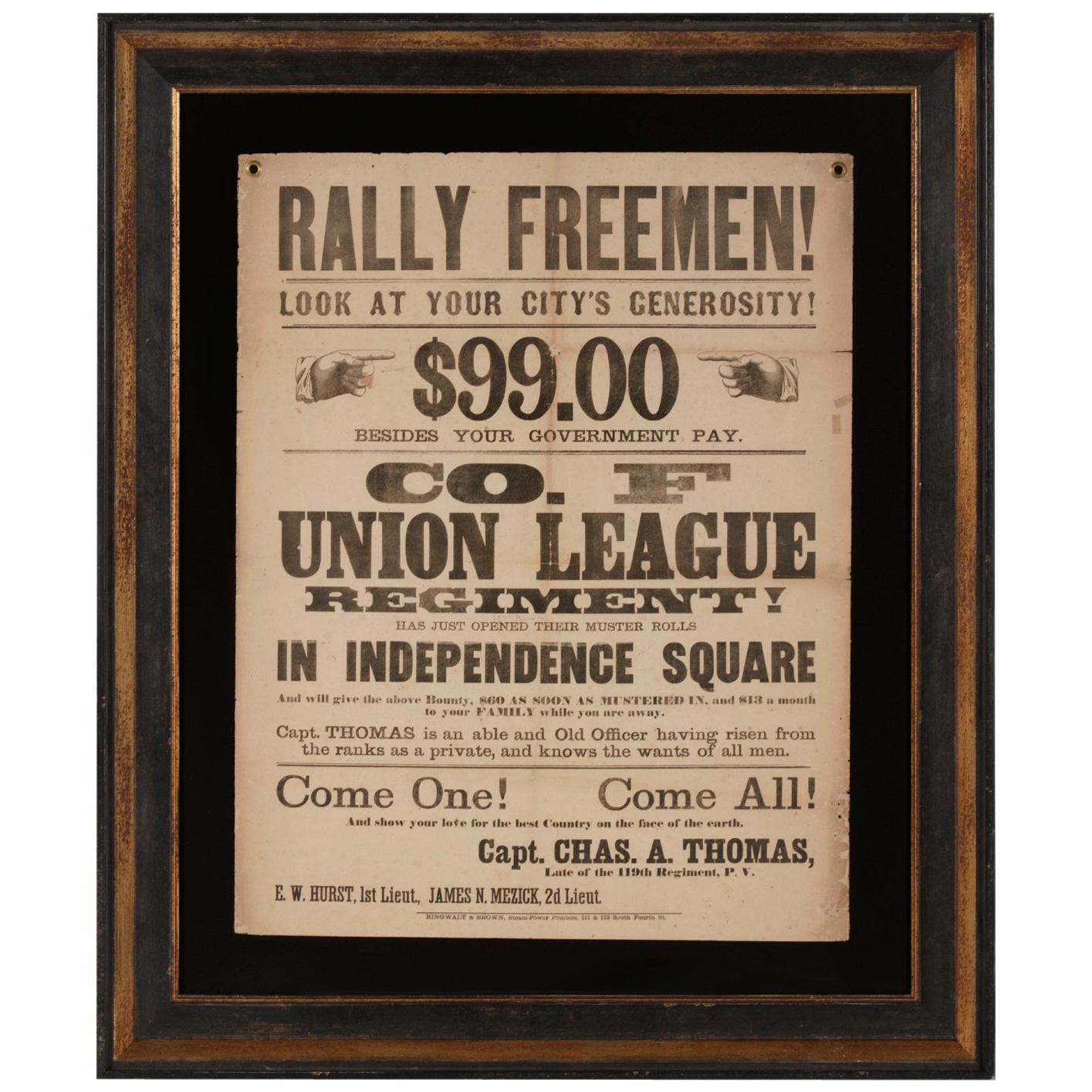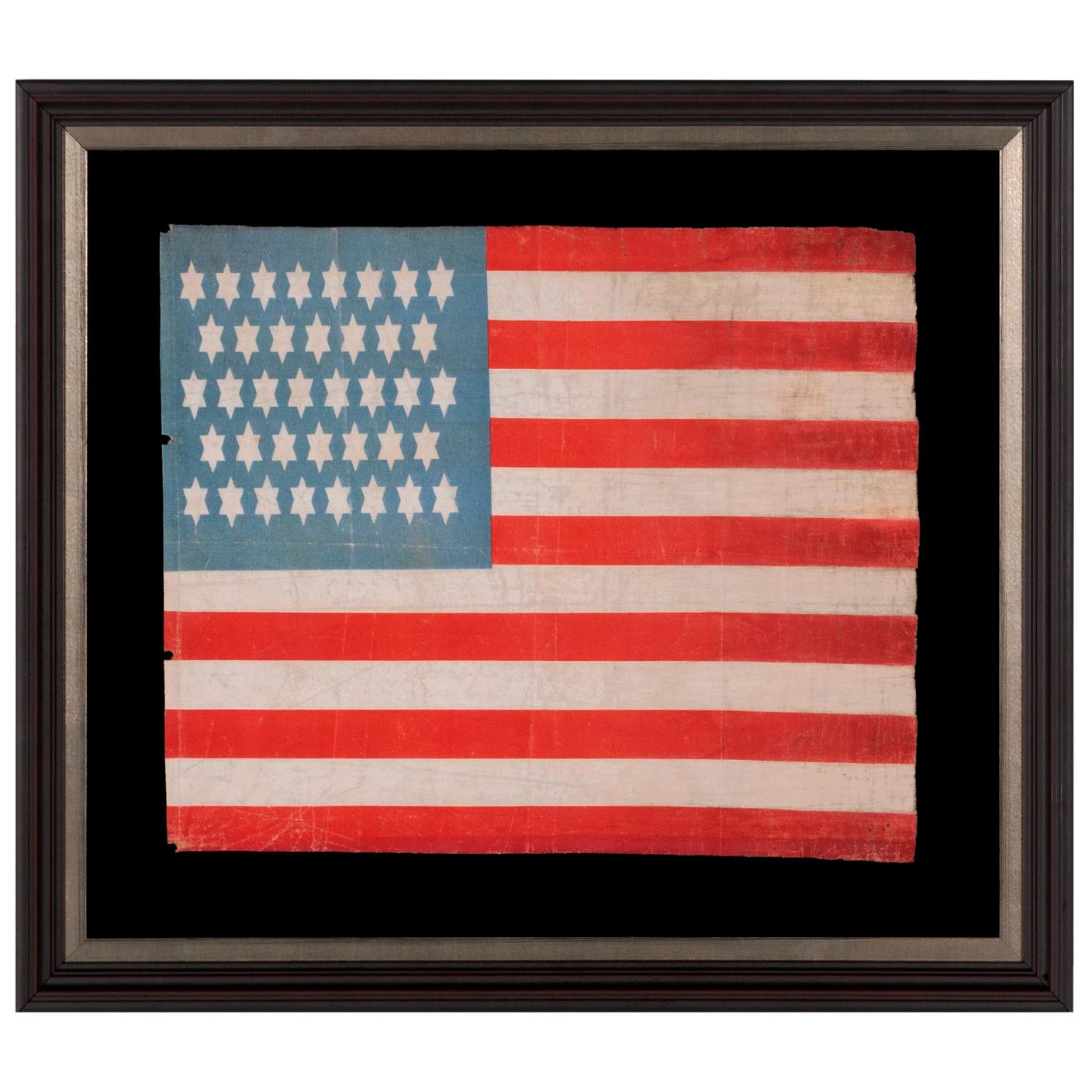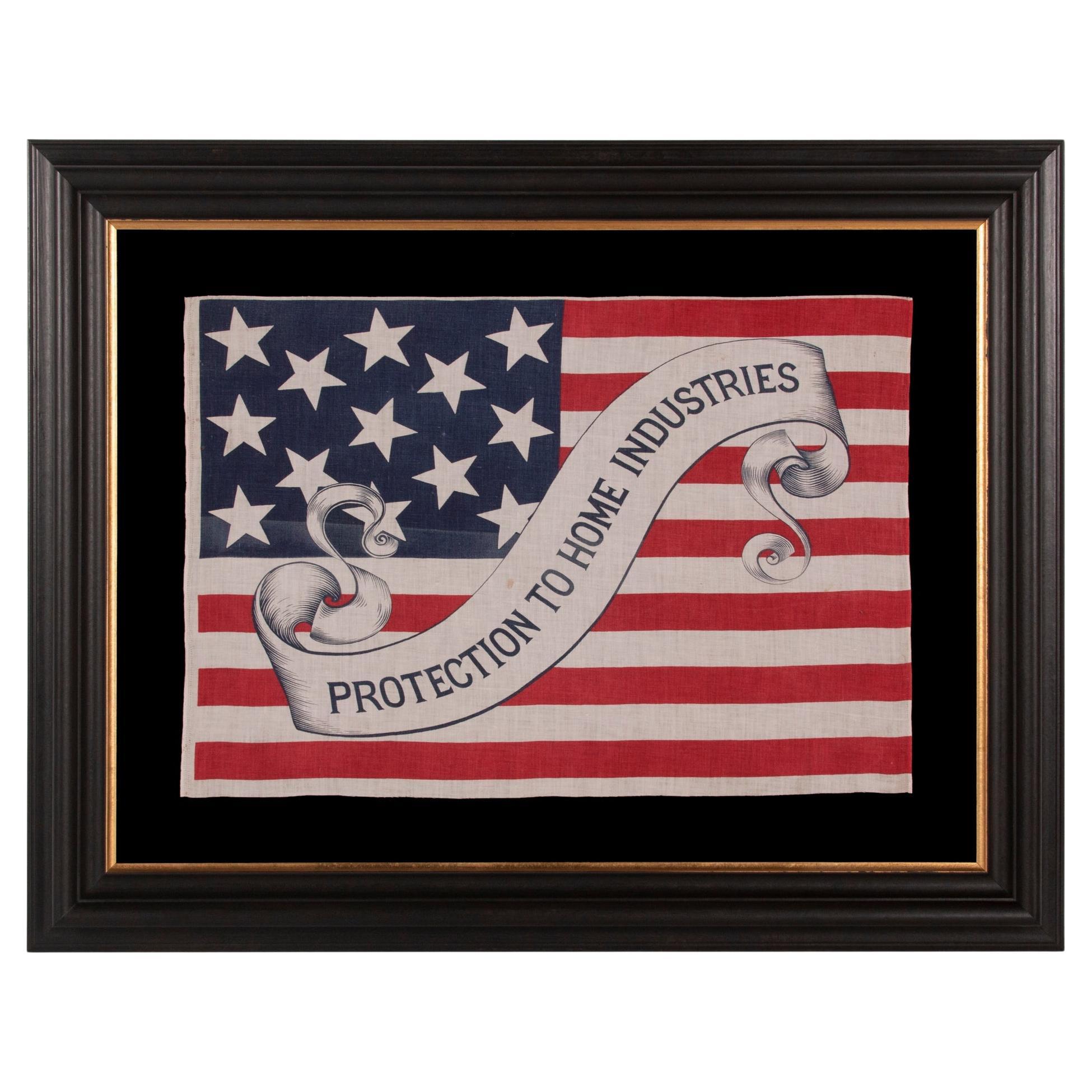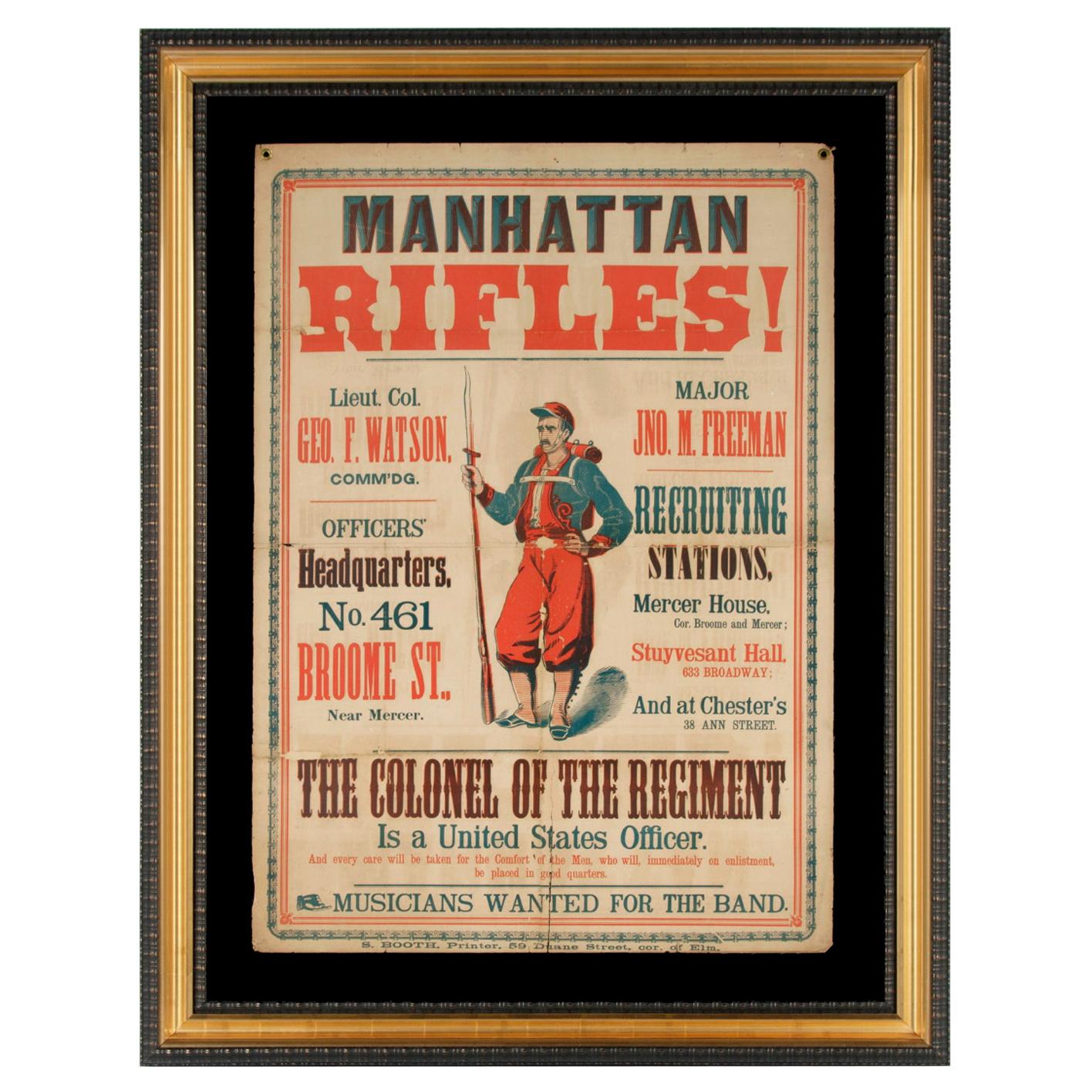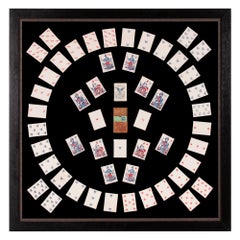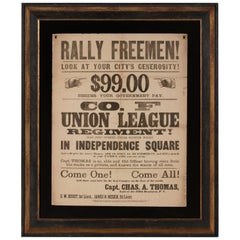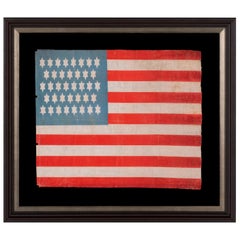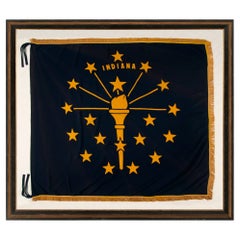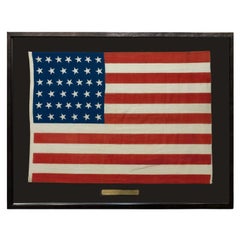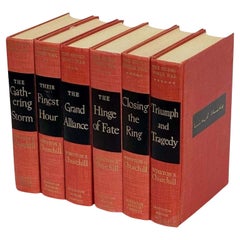Items Similar to Ohio State Parade Flag with a Civil War Veterans Overprint
Want more images or videos?
Request additional images or videos from the seller
1 of 8
Ohio State Parade Flag with a Civil War Veterans Overprint
About the Item
OHIO STATE FLAG WITH CIVIL WAR VETERANS' OVERPRINT FROM THE GRAND ARMY OF THE REPUBLIC POST IN COLUMBUS, MADE IN MOURNING OF THE 1925 PASSING OF NATIONAL G.A.R. COMMANDER IN CHIEF DANIEL M. HALL, WHO ALSO SERVED AS COMMANDER OF THE OHIO DEPARTMENT OF THE G.A.R., AS WELL AS THE LOCAL CHAPTER
Flag of the State of Ohio, printed on oilcloth-like cotton, affixed to its original wooden staff. Made for Civil War veteran's use, the flag bears a stamped overprint in the striped field that consists of an open wreath of laurel branches, inside which is the following text: “GAR [Grand Army of the Republic] Post, Dan Hall, Columbus, OH”.
Born on October 20th, 1842, Daniel M. Hall enlisted with the Union Army as a Private at the age of 18 on August 25th, 1861. On October 8th of that year he mustered into the Co. H of the 2nd Ohio Cavalry. Discharged for disability on June 28th, 1862, he reenlisted approximately 17 months later, on November 11th, 1863, and mustered into Co. F of the 12th Ohio Cavalry at Camp Cleveland. He was at some point promoted to the rank of Sergeant, and, on February 21st, 1864, to the rank of Corporal. He mustered out at Nashville on November 14th, 1865.
Hall mustered into the Hamlin Post of the Ohio G.A.R. on May 23rd, 1883. He would go on to serve not only as Commander of the Dept. of Ohio for the organization, but as National Commander of the entire Grand Army of the Republic.
The Grand Army of the Republic was the primary veterans association for Union Civil War soldiers. Founded in 1866, its members dressed up in Civil War uniforms, attended parades and reunions, and the organization was somewhat more fraternal in nature than today’s VFW or American Foreign Legion.
Flags overprinted for the purpose of advertising are a specialized form in American flag collecting. A flag with a basic G.A.R. overprint is the most common type. This might be accompanied by a post number and a date. More elaborate the overprints are more highly desired, such as this one, which is the only variation I know of that honors a particular person who was not the namesake of the chapter itself.
It is of interest to note that a sister variety of 48 star parade flag is known, printed on the same fabric, that bears the same overprint, accompanied by the words: “We Mourn Our Comrade." From the additional text on the 48 star variety, one can extrapolate that the flags were made to mourn the passing of this important leader of Civil War veterans on October 19th, 1925, just one day before his 83rd birthday.
The State Flag of Ohio was designed in 1901 by Cleveland architect John Eisenmann, who designed the Ohio building for the state's exhibition at the Pan American Exposition World's Fair in Buffalo, New York. It was officially adopted by the Ohio legislature on May 19th, 1902. It's elements are centered on a red disc, set against a circular white ground that forms a letter "O." This simultaneously represents a buckeye, the fruit of the state tree and an iconic Ohio symbol. The flag's 5 stripes are said to represent the state's waterways and roads, while the triangular shape of the union is said to illustrate hills and valleys. The presentation of 13 stars along the hoist end, arranged in a semi-circular medallion with two off-set stars above and below, reflects the original 13 colonies. The diamond of stars, towards the fly end. bring the overall count to 17 to reflect Ohio's admission. When the design was adopted by the state legislature, the position of these stars was changed slightly, moving them further around the circle to form a wreath.
Flag expert Whitney Smith, who coined the term Vexillology in the late 1950's (the accepted term for the study of flags), pointed out that the format of the flag itself was reminiscent of Civil War cavalry guidons, carried by Ohio regiments throughout the state. These were of swallowtail form, though with 13 stripes, all horizontal and 90 degrees to the hoist. Most often these had circular star patterns around an open center, which makes them even more similar to the Ohio flag. Although these were carried everywhere throughout the North, the flags are certainly similar. The Ohio flag, however, is in the shape of a ship's burgee rather than that of a U.S. Cavalry guidon. This is especially appropriate due to the importance of the Ohio River, as well as Lake Erie. For thousands upon thousands of American settlers, the Ohio River, largest of the Mississippi's tributaries, was the gateway to the American West. Its own tributaries provided transport throughout the state itself, while Lake Erie opened passage to Michigan and beyond. All were the lifeblood of industry and trade.
Brief History of the 2nd Ohio Cavalry and the 12th Ohio Cavalry during Daniel M. Hall's tenure with the units:
2nd Ohio Cavalry:
Second Cavalry. - Cols., Charles Doubleday, August V. Kautz, Bayard Nettleton, Dudley Seward; Lieut.-Cols., Robert W. Ratliff, George A. Purington, David E. Welch; Majs., Henry F. Willson, George G. Miner, Henry L. Burnett, Albert Barnitz, Hyman N. Easton, Rynd E. Lawder.
The 2nd cavalry was recruited and organized under the supervision of Hon. B. F. Wade and Hon. John Hutchins, in the summer and fall of 1861, to serve for three years, and rendezvoused at Camp Wade. Early in Jan., 1862, under orders from the war department, the regiment proceeded by rail via Cincinnati, St. Louis and St. Joseph to Platte City, Mo. In February a scouting party of 120 men of the regiment was attacked in the streets of Independence by an equal force under the command of the subsequently noted Quan- trill, but as the results of the regiment's "first fight," Quantrill was routed in 15 minutes, losing 5 killed, 4 wounded and 5 captured, the Ohioans losing 1 killed and 3 wounded. (Source: The Union Army: A History of Military Affairs in the Loyal States, 1861-65…, Vol. 2).
At this point, Hall was discharged for disability.
12th Ohio Cavalry:
Col., Robert W. Ratliff; ; Lieut.-Cols., Robert H. Bentley, John F. Herrick; Majs., Miles J. Collier, Erastus C. Moderwell.
This regiment, from the state at large, was organized at Camp Cleveland from Aug. 7 to Nov. 24, 1863, to serve for a term of three years. On Nov. 29 it moved to Louisville, then to Lexington and Mt. Sterling, and at the latter place was closely engaged with the Confederates in the following June, behaving with great gallantry and being especially complimented by Gen. Burbridge. It overtook Morgan [Morgan's Raiders] at Cynthiana and fought with him, scattering his forces in every direction. In October it was engaged for half a day in hard fighting at Saltville, finally charging up a hill and driving the enemy from his works. It did its full share of duty under Gen. Stoneman, at Bristol, Abingdon and Marion; thence as support to Gen. Gillem in his pursuit of Vaughn; then back again to Marion, where Stoneman engaged Breckenridge for 40 hours, and finally defeated him. In December Saltville was captured and the forces returned to Kentucky, regimental headquarters being established at Richmond. In the spring of 1865 it again formed part of a raiding expedition under Gen. Stoneman, during which Salisbury, with its stores and the Federal prisoners con-fined there, fell into Union hands. The regiment was mustered out on Nov. 14, 1865, at Nashville, Tenn., in accordance with orders from the war department. (Source: The Union Army: A History of Military Affairs in the Loyal States, 1861-65…, Vol. 2)
Mounting: The flag was mounted and framed within our own conservation department, which is led by expert staff. We take great care in the mounting and presentation of flags and have preserved thousands of examples.
The black molding has a scooped profile, with red undertones and highlights. To this a rippled profile molding, black with gold highlights, was added as a liner. The background is 100% cotton twill, black in color. Spacers keep the textile away from the glass, which is U.V. protective.
Condition: Excellent.
Frame size (H x L): Approx. 14.5" x 10.25"
Flag size (H x L): 4" x 6" on a 10" staff.
- Dimensions:Height: 14.5 in (36.83 cm)Width: 10.25 in (26.04 cm)Depth: 2 in (5.08 cm)
- Materials and Techniques:
- Place of Origin:
- Period:
- Date of Manufacture:1925
- Condition:See Item Description.
- Seller Location:York County, PA
- Reference Number:Seller: ofj-9401stDibs: LU849715099031
About the Seller
5.0
Recognized Seller
These prestigious sellers are industry leaders and represent the highest echelon for item quality and design.
Established in 1991
1stDibs seller since 2008
69 sales on 1stDibs
Typical response time: 8 hours
- ShippingRetrieving quote...Shipping from: York County, PA
- Return Policy
Authenticity Guarantee
In the unlikely event there’s an issue with an item’s authenticity, contact us within 1 year for a full refund. DetailsMoney-Back Guarantee
If your item is not as described, is damaged in transit, or does not arrive, contact us within 7 days for a full refund. Details24-Hour Cancellation
You have a 24-hour grace period in which to reconsider your purchase, with no questions asked.Vetted Professional Sellers
Our world-class sellers must adhere to strict standards for service and quality, maintaining the integrity of our listings.Price-Match Guarantee
If you find that a seller listed the same item for a lower price elsewhere, we’ll match it.Trusted Global Delivery
Our best-in-class carrier network provides specialized shipping options worldwide, including custom delivery.More From This Seller
View All1862 Civil War Playing Cards with Stars, Flag, Sheilds and Eagles
Located in York County, PA
1862 Civil War playing cards with stars, flags, shields, & eagles, and face cards illustrating civil war officers and lady, Columbia, ca 1862, Benjamin Hitchcock, New York
1862 Civil War playing cards with suits represented by stars, flags, shields, & eagles, in lieu of the traditional French suits of hearts, diamonds, clubs, and spades. The face cards feature Union Army officers and Lady Columbia [a.k.a. Lady Liberty, Goddess of Liberty]. Entitled “Union Playing Cards,” two versions of this deck were produced in New York by Benjamin W. Hitchcock’s “American Card Company.” This is the earlier of the two. The other was released in 1863.
There are 52 cards in total with the ace of spades doubling as the title card, as was often the case during the 19th century. The telescoping box...
Category
Antique 1860s American Political and Patriotic Memorabilia
Materials
Paper
Price Upon Request
"Rally Freemen!..." Civil War Recruitment Broadside
Located in York County, PA
"RALLY FREEMEN! …COME ONE! COME ALL! AND SHOW YOUR LOVE FOR THE BEST COUNTRY ON THE FACE OF THE EARTH." A CIVIL WAR RECRUITMENT BROADSIDE FOR THE...
Category
Antique 1860s American Political and Patriotic Memorabilia
Materials
Paper
38 Star Parade Flag with Whimsical 6-Pointed Stars, Colorado Statehood
Located in York County, PA
38 WHIMSICAL STARS, WITH 6-POINTED PROFILES, SIMILAR TO THE STAR OF DAVID, ON AN ANTIQUE AMERICAN FLAG OF THE CENTENNIAL ERA; A REMARKABLE SPECIMEN, ONE-OF-A-KIND AMONG KNOWN EXAMPLE...
Category
Antique Late 19th Century American Political and Patriotic Memorabilia
Materials
Cotton
Price Upon Request
Indiana State Flag, with Gold Fringe circa 1930-1955
Located in York County, PA
Indiana State Flag With Square-like Proportions, An Offset Device, And Gold Fringe, Circa 1930-1955:
Despite the fact that most of the United States joined the Union during the 18...
Category
20th Century American Political and Patriotic Memorabilia
Materials
Cotton
Price Upon Request
13 Star American Parade Flag with Rare Design, circa 1888 Ex Richard Pierce
Located in York County, PA
13 Star American parade flag in an extremely rare design, with “protection to home industries” slogan on a fanciful, scrolling streamer, made for the 1888 presidential campaign of Benjamin Harrison; formerly in the collection of Richard pierce.
1888 Benjamin Harrison campaign flag, printed on cotton, with 13 large stars in a 3-2-3-2-3 pattern, upon which a whimsical, scrolling streamer is superimposed that features the slogan: “Protection to Home Industries.”
There are numerous styles of both documented and undocumented, red, white, and blue bandanas and handkerchiefs, made for Harrison’s campaign in this year, as well as from the subsequent one, in 1892. Most bear variations of text to support the “Protection for American Industries” platform of the Republican Party. America was in the midst of the industrial age and there was a great deal of public interest, both in protecting growth and discouraging both imported goods and immigration. The constant stream of immigrants posed great challenges for a working families, competing for scarce jobs, in work environments that were already often far from ideal. In post-Civil War America, many of the working men were Civil War veterans.
Bandanas abound from Harrison’s Campaigns, but flags do not. This example, along with three others, were once part of an 1888 patriotic quilt that was disassembled by a dealer and sold piecemeal to collectors. I eventually acquired all four. Fifteen to twenty years ago, these were the only four known copies. A couple of others have since surfaced, but the total count known still stands closer to 5 than 10.
The use of 13 stars is seen in the flags of various candidates in the 19th century. Among these are Abraham Lincoln (1860 campaign), Henry Clay (1844 campaign), John Fremont (1856), and Benjamin Harrison’s grandfather, William Henry Harrison...
Category
Antique 1880s American Political and Patriotic Memorabilia
Materials
Cotton
Colorful Civil War Recruitment Broadside for the "Manhattan Rifles"
Located in York County, PA
MASSIVE & COLORFUL CIVIL WAR RECRUITMENT BROADSIDE FOR THE "MANHATTAN RIFLES,” WHICH MUSTERED INTO 43RD AND THE 57TH NEW YORK INFANTRY DIVISIONS ...
Category
Antique 1860s American Political and Patriotic Memorabilia
Materials
Paper
Price Upon Request
You May Also Like
39-Star Antique American Flag with 'Whimsical' Star Pattern, 1889
Located in Colorado Springs, CO
This is a 39-star unofficial American flag, handmade and printed on cotton. The flag dates to 1889 and has a unique history, thanks to its rare star-count.
The flag’s canton is prin...
Category
Antique 1880s American Political and Patriotic Memorabilia
Materials
Cotton
38-Star Antique American Flag with Unique Canton, circa 1876-1890
Located in Colorado Springs, CO
This is a striking 38-star American flag. The flag dates to 1876-1890, when Colorado (represented by the large star in the center of the flag’s canton) joined the Union as the 38th s...
Category
Antique Late 19th Century American Political and Patriotic Memorabilia
Materials
Muslin
Antique Federal Eagle American 50 Star Flag with Brass Eagle Pole, 19th Century
Located in Oklahoma City, OK
Monumental 50 star American Flag with antique Federal Eagle brass and wood pole. A patriotic piece suitable for any home. This set includes both ...
Category
Antique 19th Century American Federal Political and Patriotic Memorabilia
Materials
Brass, Bronze
$4,800 Sale Price
20% Off
"The Second World War, " by Winston Churchill
By Houghton Mifflin & Co.
Located in Austin, TX
The Second World War by Winston Churchill from Houghton-Mifflin Company, Boston.
A vintage edition of Winston Churchill's six-volume memoir, The Second World War, for which he was a...
Category
Mid-20th Century American Modern Books
Materials
Paper
46-Star American Flag Printed in Drum Star Configuration
Located in Colorado Springs, CO
This is an original 46-Star American parade flag, celebrating Oklahoma statehood. Each star on the flag's canton represents a state in the Union at the time. The official flag design would update every July 4th, to include any new states added to the Union in the past year. Oklahoma, the 46th state, entered the Union on November 16, 1907. As such, this 46–star flag was the official flag of the United States from July 4, 1908, until July 4, 1912.
The silk flag has a dark blue canton with 46 white printed stars. The stars are printed in an 7-8-8-8-8-7 row configuration, or “Drum design.” The flag design is completed with 13 alternating red and white stripes, each stripe representing one of the original thirteen colonies.
The land that comprises Oklahoma today was added to the United States as part of the Louisiana Purchase of 1803. Throughout the 19th century, the U.S. government relocated Indian tribes from the southeastern United States to the area, and by 1900, over 30 Indian tribes had been moved to what was originally called the Indian Territories. At the same time, ranchers in Texas began to move into the area in search of new pasture lands. Although stipulations in the Indian Relocation Act agreed that the land would forever be Indian Territory, the promise of fertile farmland trumped the government’s promise of sovereignty.
On April 22, 1889, they opened the land to settlement by homesteaders, creating a land run in which settlers, called “Boomers,” were allowed to cross the Texas or Arkansas border at a particular hour to claim homesteads. Settlers who illegally crossed the border earlier to stake prime land were called “sooners,” which eventually became the state’s nickname. Wagons and the Santa Fe railroad carried cartloads of men and women to blank town sites and building plots, creating ten thousand-people communities in a matter of days. The following year, the region was further divided into Indian Territory and Oklahoma Territory...
Category
Vintage 1910s American Political and Patriotic Memorabilia
Materials
Silk
King Edward VII Coronation, June 1902 Framed Red Flag
Located in Hastings, GB
King Edward VII coronation, June 1902 framed scarf / flag.
This scarf is an original antique piece of British history and patriotic memorabilia.
...
Category
Antique Early 1900s British Edwardian Political and Patriotic Memorabilia
Materials
Cotton
Recently Viewed
View AllMore Ways To Browse
Gold Stater
Used Furniture Ohio
A And O Dress
World War 2 Furniture
Gold Bentley
Star Wars Furniture
Antique Flag Frame
Union Flag
Mounted American Flag
U S Flag
American Flag Framed
Framed American Flags
Flag Diamond
Folk Art American Flag
Parade Flag
Antique American Flag Framed
Space Memorabilia
American Flag Cotton

